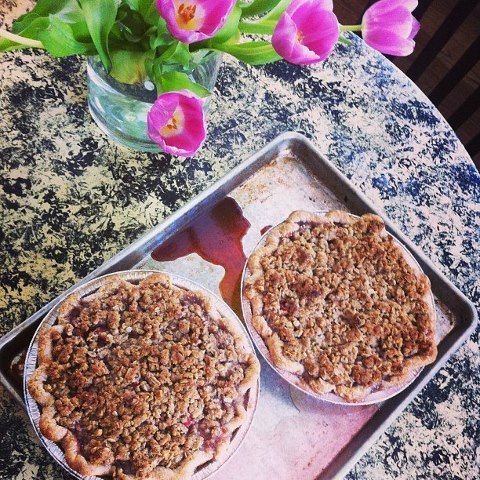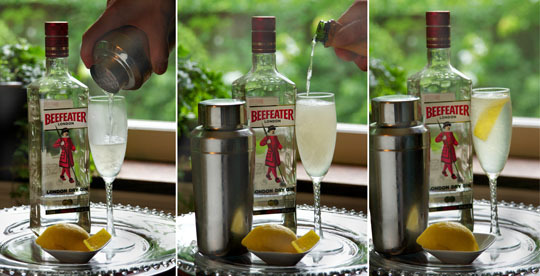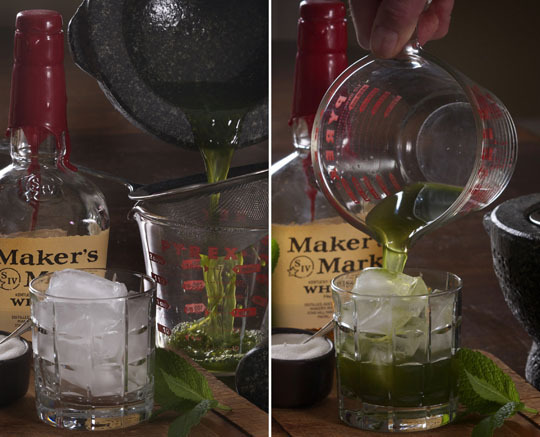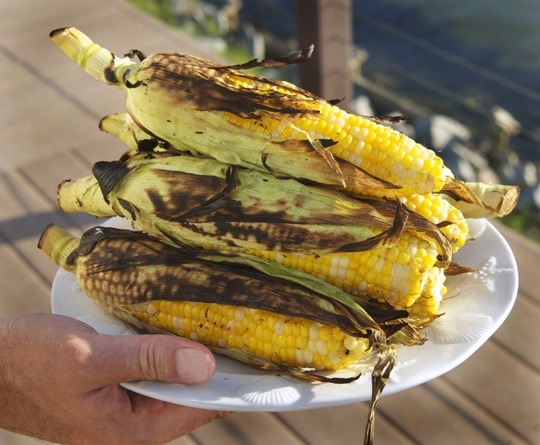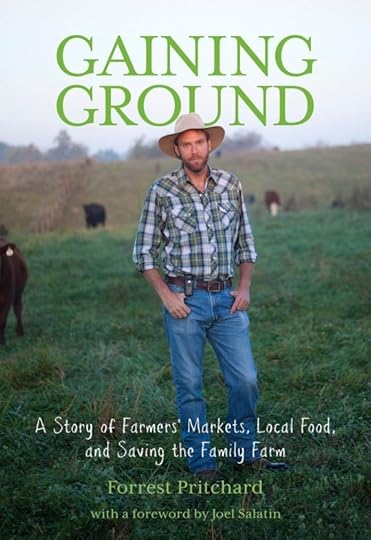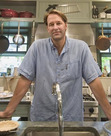Michael Ruhlman's Blog, page 40
June 10, 2013
Rhubarb Walnut Crumble Pie
Lisa Ludwinski is a baker and cook living in Ferndale, Michigan. She recently returned to the Great Lakes State after a six-year stint eating bagels, nannying, and mixing many pounds of cookie dough in Brooklyn. Now she is the owner of Sister Pie, a from-scratch home bakery serving the Detroit area via the Facebook page, and aims to celebrate the seasons with pie and other sweets through unique interpretations and natural ingredients. I like to make a lattice top, which allows all of the moisture to escape efficiently (and I’ve reduced the pie crust ratio to 12-8-4 ounces of flour-butter-water), but a loose crumble allows for the same reduction; it’s also a great all-purpose topping for any fruit dessert. Lisa thickens the cooked fruit with tapioca; cornstarch will also work. I wholeheartedly support her urging you to avoid using a strawberry-rhubarb mixture and feature the amazing rhubarb on its own.—MR
Rhubarb Walnut Crumble Pie
by Lisa Ludwinski
The first time I made strawberry-rhubarb pie, I went in blindly. It was four years ago, for an episode of my cooking show I produced in order to challenge myself to learn to cook, to bake, and, ultimately, to improvise. The fact that I had never tasted rhubarb or that I had only tried my hand at homemade pie crust maybe once or twice before simply came with the territory. The pie was a success, and as I shamelessly devoured piece after piece, I imagined future Mays and Junes, newly rhubarb-filled and happy.
Fast-forward to today, many crumbles, crisps, and cobblers later, and I adore that tart perennial more than ever. Now I sell pies for a living, so I’ve been dreaming up this particular rendition in eager anticipation for months. First things first: lose the strawberries! Rhubarb on its own has unmatched flavor and enough star quality to carry a pie to heavenly levels. Another important note, which you’ve undoubtedly heard before: take the time to make a crust from scratch—really! Your skills will improve each time you try, and your pie will turn pie-haters into pie-lovers and eventually pie-bakers. And what’s the worst that could happen? You piece together a crumbly mess of flour, butter, salt, and water and press it into a pie tin—it’s going to be delicious regardless of its appearance.
Enter Rhubarb Walnut Crumble pie: rhubarb is gently tamed with sugar, orange, and cinnamon and placed into a flaky, all-butter crust spiked with whole-wheat flour to highlight the nuttiness of the crumble topping, made from lightly toasted walnuts, browned butter, and oats. The intoxicating aroma of pie baking in your oven will make it hard to resist digging in immediately, but it’s worth the wait for it to cool. The filling will thicken as it cools, and while you wait you can whip up some cream to dollop on each slice. Do it by hand—you might as well learn two impressive skills today.
Rhubarb Walnut Crumble Pie
For the crust:
1 cup unbleached all-purpose flour
1/4 cup whole-wheat flour
1/2 teaspoon sugar
1/2 teaspoon salt
1/2 cup unsalted butter, chilled and cut into chunks
2 to 5 tablespoons ice water
For the walnut crumble:
6 tablespoons unsalted butter
1/2 cup rolled oats
1/4 cup lightly toasted chopped walnuts
1/4 cup light brown sugar
1/4 cup all-purpose flour
1/4 cup whole-wheat flour
1/4 teaspoon cinnamon
1/4 teaspoon salt
For the rhubarb filling:
5 cups sliced rhubarb
1 1/4 cups granulated sugar
5 tablespoons instant tapioca
1 teaspoon grated orange zest
1/4 teaspoon cinnamon
pinch of salt
2 tablespoons cream cheese, at room temperature
To make the crust, combine the flours, sugar, and salt in a mixing bowl. Using a pastry blender or two forks, cut in the butter until it resembles coarse meal. It’s okay if the butter bits are different sizes, so long as none of them are larger than peas. At this point, add the ice water a tablespoon at a time and begin to gather the dough together. Turn the dough over itself a few times, but be careful not to overwork it. Pat the dough into a round disc and wrap in plastic to chill for a couple of hours (or at least 30 minutes).
To make the crumble, melt the butter over medium heat in a small saucepan. It will start to bubble and foam. Soon you will see little brown specks at the bottom of the saucepan, and smell a wonderfully nutty fragrance of freshly browned butter. Take the saucepan off the heat and let it cool.
Meanwhile, in a small bowl combine the oats, walnuts, brown sugar, flours, cinnamon, and salt. Once the butter has cooled somewhat but is still fluid, add it to the oat mixture and mix until incorporated. Set aside, or refrigerate for later.
To make the pie: Flour your work surface and place the unwrapped pie dough in the center. Using your favorite rolling pin (I prefer a French tapered pin, like this), press along the edges of the round, broadening the circle. You can move the disc around with your hands as you do this, making sure to flour the surface again when needed. Begin to flatten the pie dough into a larger circle by rolling from the center out. Roll, then rotate the disc and roll again. Don’t forget to keep flouring the surface. You can flip the disc and repeat this process until you have a circle of even thickness, about 12 inches in diameter. Invert your pie tin or dish onto the circle, and use a pastry cutter or knife to trim the dough, leaving a 1-inch border around the tin. Remove the pie tin and fold the dough in half. Place the folded dough into the pie tin, unfold it, and gently press it in, making sure it’s centered and fitted properly. To create a crimped edge, roll up the dough overhang toward the center of the pie, creating a ring of dough. Use the thumb and index finger of one hand to make a “V” and use the index finger of your other hand to press into the “V,” making a crimp. Continue until the entire ring of dough is crimped.
At this point, you can put the crust in the refrigerator while you make the rhubarb filling. Congratulations, by the way! The hardest part is over.
Preheat your oven to 425°F/218°C with a rack on the lowest level.
Mix the rhubarb, granulated sugar, instant tapioca, orange zest, cinnamon, and salt in a bowl until uniformly combined.
Remove the rolled-out pie crust from the refrigerator and use an off-set spatula or spoon to spread an even layer of cream cheese on the bottom of the crust. Fill the shell with the rhubarb mixture, and top with the walnut crumble.
Bake the pie on a sheet tray (lined with aluminum foil for easier clean-up if you wish) at 425°F/218°C for 15 minutes, then lower the temperature to 375°F/190˚C and bake until the juices are bubbling all over and the crumble is browned, another 40 to 50 minutes. Cool the pie for at least 2 hours before slicing.
If you liked this post, take a look at these links:
My past posts on quiche Lorraine and cherry pie.
Learn more about rhubarb, which is actually a vegetable.
The Brown Eyed Baker has many recipes for your inner baker.
Check out these pie companies: Hoosier Mama Pie, Bang Bang Pie Shop, and Achatz Handmade Pie Company.
© 2013 Michael Ruhlman. Photo © 2013 Donna Turner Ruhlman. All rights reserved.
June 7, 2013
Friday Cocktail Hour: The French 75

The classic French 75. Photo by Donna Turner Ruhlman.
It’s a celebratory week here in the Ruhlman household. Two significant graduations and the 18th birthday of my daughter. So bubbly is on hand, and it led me to this thoroughly refreshing and restorative cocktail, the French 75, which I was first introduced to at the Velvet Tango Room. The concoction was apparently named after a French field gun, owing to its kick, at Harry’s Bar in Paris, and I love its French name best, Soixante Quinze.
It couldn’t be simpler: a gin sour (lemon juice and simple syrup), topped with dry sparkling wine, finished with a twist.
Best wishes to all on this first Friday of June, but especially to the parents out there with kids who are graduating.
The French 75
2 ounces gin
1/2 ounce lemon juice
1/2 ounce simple syrup
Bubbly as needed
Lemon twist
Combine gin, lemon juice, and simple syrup in a shaker with ice. Swirl till thoroughly chilled.
Strain into a chilled champagne flute.
Top with sparkling wine.
Garnish with a twist.
If you liked this post, take a look at these links:
My recent cocktail posts that include gin are the Hasty Negroni, Boulevardier, Tom Collins, and the classic Manhattan.
The Hour: A Cocktail Manifesto, by Bernard DeVoto, is a lovely meditation on that heavenly time of day.
Letherbee Original Label is an interesting Chicago gin you should try when you come to town.
Be on the lookout for Two James distillery in Detroit—they make gin, rye, whiskey, and vodka.
© 2013 Michael Ruhlman. Photo © 2013 Donna Turner Ruhlman. All rights reserved.
June 4, 2013
Travel: Charleston, SC
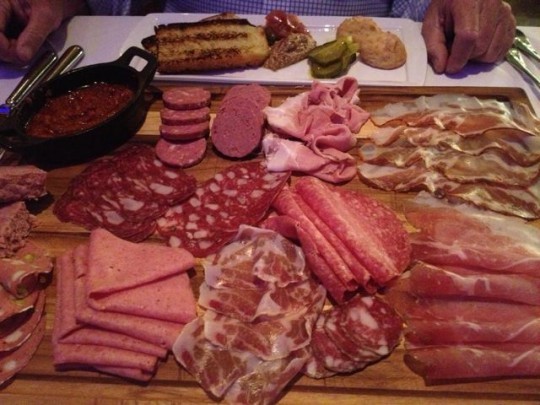
Charcuterie platter at Cypress. Photo by my iPhone.
Returned from one full week in Charleston feeling as never before what an exciting food town it has become. While I was there to film more Le Creuset demos at their new headquarters with Taste Five Media, as part of the fun I got to explore the town some more. By chance the Spoleto festival was underway and my dear mum was in town with friends. She’d booked a table at Cypress where Craig Deihl continues to serve house-cured salumi that is second to none in the country that I’ve tasted. My favorite was the Braunschweiger, smoked liverwurst. Most interesting charcuterie note was that for his emulsified sausages, such as the mortadella on the left, he grinds the meat five times with a powerful chopper called a Buffalo chopper.
Charleston is one of the few cities in the United States that is like no other (along with New Orleans and Key West), but it has also become a truly rich restaurant and food town, far beyond the scope of Sean Brock’s fine restaurants (the chef who first brought so much national attention to the city).
The following are a few highlights.

Sorting shrimp at Geechie Seafood.

Shrimp boat
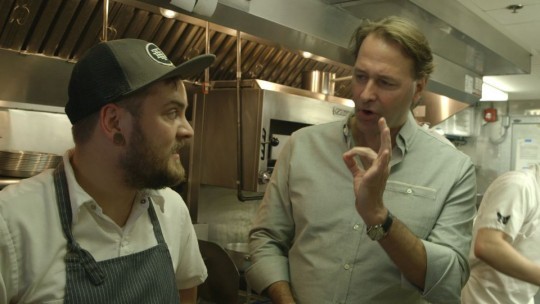
Josh Keeler of Two Boroughs Larder demoed his excellent octopus in a nduja sauce.
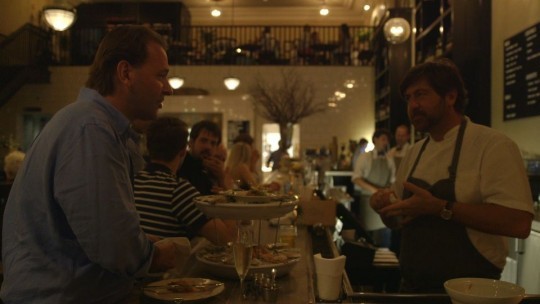
Mike Lata, right, at The Ordinary, describing the plateau de mare. Highlight, the lobster ceviche.
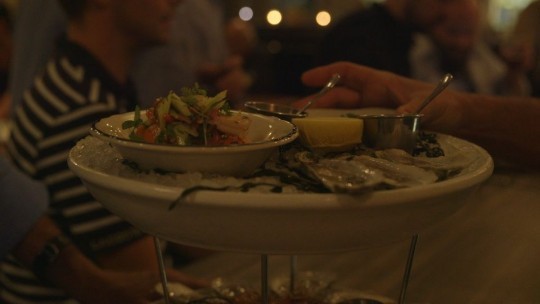
The plateau features a variety of Atlantic oysters.
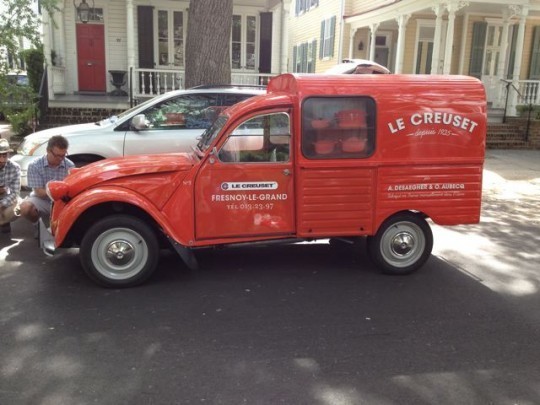
Part of the filming required my scooting up and down the street in front of the cheese shop Goat Sheep Cow in this sweet little Le Creuset truck.

Producer Matt Mosher, standing, and Zsolt Haraszti, camera operator, rigging the truck with cameras.
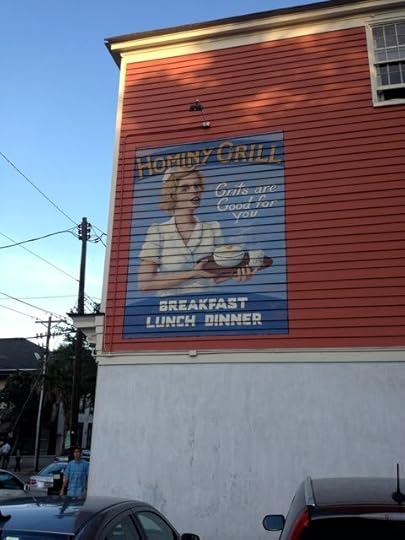
Hominy Grill is a great spot for grits and more.

Sean Brock’s Husk
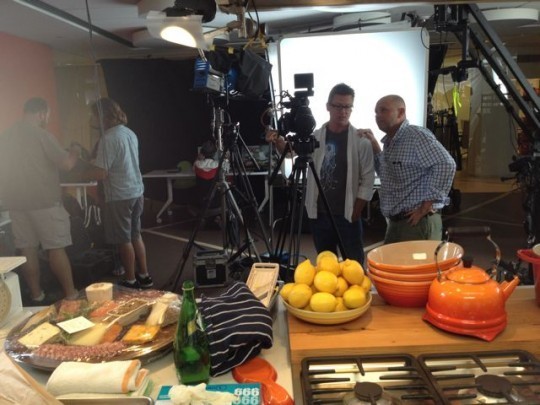
Mosher and Warren Johnson of Taste Five Media on the set at Le Crueset’s new demo kitchen.
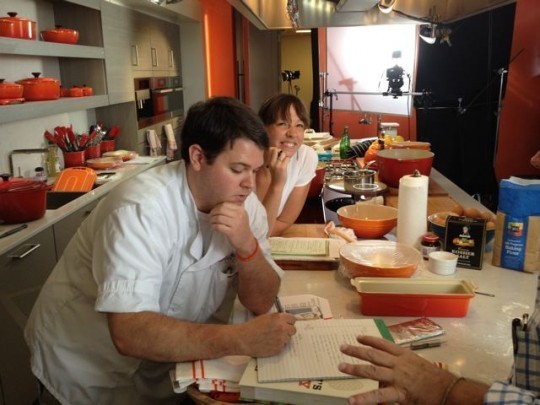
My prep leaders, Nick Garcia, sous at the Kiawah Island Club, and Maya Morrill

Check out that sink! A goose pot!

Chef Josh Walker at Xiao Bao Biscuit

I actually ordered this Xiao Bao tofu dish; I’m disturbed to tell you how fabulously pungent and fiery it was.

Jonny Cosmetics did my makeup; he told me that “entrepreneur” is not necessarily a favorable term. I guess you have to put “successful” in front of it.

End note: Among the dishes I did, a croque madame, the best sandwich ever.

Maya didn’t disagree!

A sandwich that makes you smile
Whenever I get grumpy, I need to remember how lucky I am to be able to do what I do.
If you liked this post, take a look at these links:
My recent post on America Has a Serious Eating Disorder.
My other Le Creuset posts: Baking, Gratin, Roasting, Slow Cooking, and Braising.
Travel guide to the great state of South Carolina.
Take a closer look into the city of Charleston.
© 2013 Michael Ruhlman. Photo © 2013 Donna Turner Ruhlman. All rights reserved.
May 31, 2013
Friday Cocktail Hour: Mint Julep
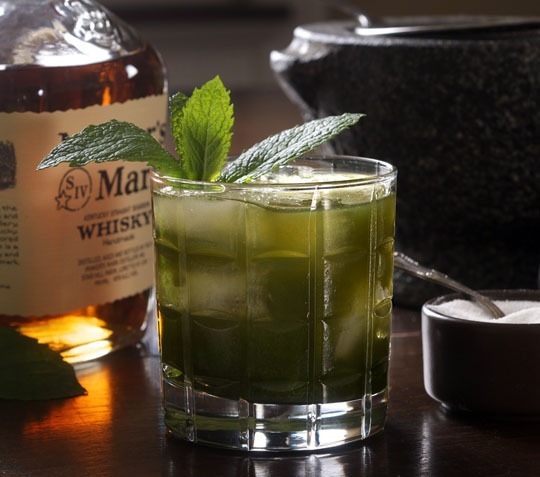
An excellent mint julep. Photo by Donna Turner Ruhlman.
In honor of the noble city of Charleston, SC, which I sadly depart today, I repost a drink I associate with the South. I had a rather tough go with my first julep experience (below), but I’ve come to regard it as one of my favorite cocktails, especially now as the mint has sprouted and the weather has warmed.
I must must must thank four souls who have made this thirteen-hour shoot not seem like even an eight-hour day, owing to the fact that they have been spending eighteen-hour days prepping out the six demos I’m filming for Le Creuset.
These souls are, of course, the cooks.
Nick Garcia, sous chef at Kiawah Island Club. He’s been the ace chef de cuisine. On the other end Tyler Osteen (@jtosteen), jack of all or at least some or at least a couple trades, who appeared with a Stella for me tonight when it was most needed, when he wasn’t washing dishes or cutting food. Brad Norton, up to interesting food biz down here that I look forward to writing about in full soon (Revival Foods), and last but not least, the lovely Maya Morrill. You know those positive forces, the kind of soul who finds something to smile and laugh about while juggling seventeen different pizzas in two unfamiliar uncalibrated ovens, pizzas that don’t even have to taste good, only look perfect on cue, now! She is a private chef, food stylist, demo specialist (word!), and singer songwriter.
Is it any wonder cooks are more often than not the best souls on earth?
This julep’s for you, guys. (For godsake, stay away from writers.) —MR
Mint Juleps, the Good and the Bad
Originally posted May 18, 2012
My first mint julep was made for me by a guy who remains one of my dearest friends and confidants. We were wayward, then, but he has gone on to be a talented and superlative writer, generally. Having at the time (1987) a Kentucky girlfriend and having recently spent four years at Tulane, he knew his juleps.
The night ended badly. Blown speakers at my girlfriend’s apartment and roof tar all over her nice wood floors—she was pissed, and I staggered out into the early spring sunshine. On the subway home the next morning from 110th and Amsterdam to 39th and 1st—wouldn’t you know it—I heard, “Michael?!” An old high school girlfriend had spotted me, my first kiss actually, and still dear friend. She picked lint out of my unshaved face and, with concern and disappointment, told me I needed to get some rest.
My apartment was chained shut so I had to knock. Billie Holiday was on the speakers. An unclad, unfamiliar female form crossed what I could see through the crack. My roommate, the mint julep maker, opened the door scratching his head apologetically. I told him my mother was arriving in hours, get the woman out. He told me, “She’s eating a sandwich.” I repeated my request. He paid the woman and asked her to leave. My roommate was unclear on exact details. I found gum wrappers in my sheets.
The next julep I had, several years later, was at the Oak Room, with the woman who would become my wife and has been a decidedly better influence on me. It was an August afternoon and hot, but the Oak Room was cool and dark, and Donna said, “Wouldn’t a mint julep be perfect?” We asked our server. He returned saying that the bar didn’t have any mint but surely there must be a sprig somewhere in The Plaza Hotel, and they were scouring it now. The juleps, only slightly delayed, were delivered proudly by the server. The server was duly thanked and generously tipped for his extra effort. They were perfect. Donna and I left the Oak Room, hand in hand, giddily in love.
Interesting how stories come readily attached to specific drinks.
Today, with springtime in full flush, the mint already plentiful—mint is excellent to have on hand, but it’s a weed, so be careful where you plant it—juleps will be the evening cocktail. Traditionally, a mint julep is nothing more than mint muddled with sugar, combined with bourbon and ice.
I’ve enhanced this one. I pulverize the mint in a mortar and pestle with sugar and a little of the bourbon, then add the bourbon, let it sit a few minutes to absorb the mint, then strain it over ice. Pulverizing it gives the drink extra spiciness. I then give it a squeeze of lemon to balance the sugar. I missed the Kentucky Derby this year, but I don’t have to miss the mint julep.
An Excellent Mint Julep
10–12 broad leaves of mint, plus a sprig for garnish
2 teaspoons sugar
3 ounces Maker’s Mark (or bourbon of your choice)
Lemon wedge
Combine the mint, sugar, and 1/2 ounce of bourbon in a mortar and pulverize it with a pestle.
Add the remaining bourbon and let it rest while you ready a lowball glass with ice.
Strain the bourbon over the ice (I actually strained it into a 2-cup measuring glass because my mortar and pestle is so big and heavy, then poured it over the ice). Press the mint in the strainers to squeeze as much liquid out as possible. Squeeze in some lemon juice.
Serves 1 (1 is just right, 2 is too many, 3, as I learned in New York, is never enough).
If you liked this post on the mint julep, check out these other links:
My recent cocktail posts on the Meyer Lemon Fig and the Key Sunrise.
The Kentucky Derby Museum discusses mint julep glassware.
Here are 5 ways you can mix a mint julep.
Grow your own mint for more mint juleps or mojitos.
Epicurious has a list of varied recipes for using mint.
© 2013 Michael Ruhlman. Photo © 2013 Donna Turner Ruhlman. All rights reserved.
May 29, 2013
Stephanie’s Cheese Rant
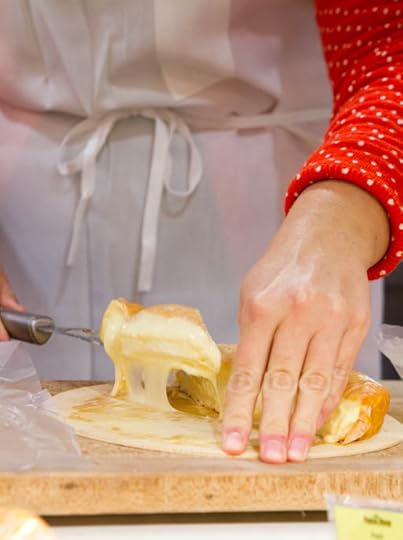
Cheese. Photo by Stephanie.
Stephanie Stiavetti (@sstiavetti) writes The Culinary Life blog. Her first book, Melt: The Art of Macaroni and Cheese , will be published next year by Little, Brown.
by Stephanie Stiavetti
If you’re a regular reader of Michael’s site, then you’re probably one of a class of people that thinks a lot about food. You might make it a point to buy quality ingredients, mostly prepare your meals at home, and generally spend a fair amount of time thinking about what you put in your body. What baffles me, though, is that despite all the grass-fed beef and produce carefully selected at the local farmers’ market, a huge number of the people in this food-conscious demographic still buy crappy, industrially produced cheese. These folks have educated themselves about many other aspects of what they eat, but are seemingly unaware that these cheeses are on par with the same processed foods they spend so much money and energy avoiding.
Then there’s an interesting class of in-betweens, somewhat cheese-savvy individuals who consciously go out of their way to buy specialty cheeses for a cheese plate, but when it comes to the cheese they’re putting on a burger, in a casserole, or on top of their pasta, they still reach for the dairy equivalent of a Pop Tart. Pisses me off. And it’s a big part of why I wrote a whole book dedicated to cooking with “real” cheese (with friend and fellow writer Garrett McCord, out from Little, Brown this fall).
Why is it that the quality and origin of one’s cold cuts warrants so much critical thought, yet not nearly as much attention is paid to the cheese that’s slapped on top of food before calling it dinner? If you notice a difference when you eat fresh, locally sourced meat and vegetables, I guarantee that you’ll find a huge difference between high- and low-quality cheeses.
So listen up! School’s in session. Today I’m going to give you a quick primer on basic cheese vocabulary. These terms will help you to become a better cheese buyer and, consequently, a healthier, more satisfied cheese eater.
Artisan, Specialty, or Mass-Produced Cheeses?
There are many ways to classify cheeses, but some would argue that it’s most important to properly categorize varieties by how they are produced. Cheeses generally fall into one of four production categories: industrially produced, specialty, artisan, and farmstead. How can a novice cheese buyer tell the difference between a mass-produced cheese and a farmstead cheese? Here’s how:
Industrially produced cheeses are made in large factories, often employing huge teams of workers to create the cheese. The milk comes from any number of places, including factory farming operations. The taste and texture of industrially produced cheeses are usually very consistent from one package to the next. They come wrapped in sealed plastic, often pre-sliced or in huge blocks, and are sold prolifically across the country. These are the cheeses you’ll find in the cheese aisle at your local Safeway, Kroger’s, Costco, etc. Think brands like Kraft, Sargento, President, Laughing Cow, and generic grocery store cheeses.
Specialty cheeses are produced with less mechanization than industrially produced varieties, and are usually created in somewhat smaller amounts. Specialty cheese makers pay attention to flavor and texture profiles, keeping a relatively close eye on the cheeses they produce, though these cheeses are not considered “handmade.” You can find specialty cheeses at regular grocery stores, where they’re often a little pricier than their mass-produced counterparts. Specialty cheeses are a good intersection between quality and ready availability—brands such as Kerrygold, Beemster, and Parrano, for example.
Artisan cheeses are handmade in small batches, often by just one or a small handful of passionate individuals who pay close attention to the tradition of the cheesemaker’s art. Artisan dairies employ as little mechanization as possible, adhering to more traditional methods (while working within the limitations of health and sanitation laws). You can usually find these cheeses at small local cheese shops manned by knowledgeable cheese staff. While artisan cheeses are not usually found in the huge cheese aisle at the supermarket, many big grocery chains are implementing cheese counters with a trained cheese person standing by. Brands to look for: Cowgirl Creamery, Vermont Creamery, Coach Farms, Laura Chenel, Cypress Grove, and Cabot Cheese Co-op.
Farmstead cheeses are made using milk from the cheesemaker’s own animals, meaning the cheese is produced on the farm where the animals live. A cheese can be classified as both artisan and farmstead if the cheese is made by hand and the milk comes from the farm where the cheese is made. These are cheeses you’ll find in small local cheese shops, or at the specialty cheese counter of your local grocery store (not in the cheese aisle). Think: Fiscalini, Redwood Hill, and Vermont Farmstead.
When Large Production = Small-Time Quality
While it may appear that some cheeses are created on an industrial scale, in reality they may be the combined intimate efforts of many farmers working together to create very consistent results. Take Gruyère, for example. Because of its protected origin designation, only cheese made in a very specific region of Switzerland can be called Gruyère, but there’s not just one enormous factory creating all the Gruyère that exists in the world. Many smaller dairy farms within the region work together to help produce the cheese, all of them adhering to the same specific requirements for a uniform product. If you’re curious about the original of your specific wedge of Gruyère (or any other protected cheese, such as Emmentaler, Parmigiano Reggiano, etc.), feel free to ask the staff of your local cheese shop who made, aged, and distributed the cheese you’re buying.
Other popular kinds of cheeses, such as brie, are not protected by any sort of designation, and therefore may be made on any scale without any sort of specified quality control. This means that while officially titled Gruyère will be fairly consistent, it is not necessarily the case for brie. Artisan brie can be amazing. Mass-produced brie that you find for $3 at Walmart tastes vaguely of salted pressboard and packing peanuts. Same goes for camembert, cheddar, “Swiss” cheese, and others. (Fun fact: Swiss cheese doesn’t really exist as a type of cheese. It’s the generic name for Emmentaler-like cheese produced outside the designation.)
It’s also worth noting that not all large-production cheese tastes like crap. Some big-name brands manufacture cheese at a dizzying rate while still maintaining high standards of quality. Two such examples are Tillamook and Black Diamond, both of which create very good cheddars and are available in huge grocery store chains. But the point of this post is to show the merits of selecting specialty and artisan cheeses over their factory-generated cousins, and I make it a point to select small-production cheeses because I prioritize independent producers, non-factory-farmed ingredients, and artisan-level quality. Huzzah!
How Do You Find Out?
Learning about the cheese you eat is no different than learning about the meat you’re buying. Do some research. Your best source for cheese information is a staff person at your local cheese counter. A good cheesemonger is well trained in the way of the milk and can answer your questions about the origin, content, and quality of the cheeses they stock. Given the growing popularity of handmade cheese, many large-scale supermarkets are outfitting their locations with well-stocked cheese counters. Even if your regular grocery store doesn’t have a cheese counter, you can probably find at least a few specialty brands in the cheese aisle. If all else fails, look to online cheese vendors such as Murray’s or Artisanal.
What About Price?
Quality cheeses are more expensive than their processed counterparts, as is most of the food you put in your mouth. I’m continuously hearing the complaint that good cheese is too pricey, yet these same people plunk down $10 for a dozen organic, free-range eggs. News flash: you’re digesting it all, and it all needs to be high-quality. Crappy cheese is just as bad for you as any other crappy food.
What About Fat?
Sure, there’s the argument for eating low-fat foods, and a huge number of Americans still buy fat-free cheeses, which are generally not available from anywhere but industrial brands. Cheese is composed primarily of fat. Fat-free cheese isn’t really cheese. But much like the stance Michael has taken on salt—that if you don’t glut yourself on sodium-laden processed food, you don’t have to worry a whole lot about the salt you use to season your homemade dishes—I take a similar position on fat. If you cut out processed high-fat foods, the fat you consume from a moderate amount of real cheese isn’t going to hurt you. In fact, there’s a whole cookbook dedicated to the idea of fat as a healthy, necessary part of your diet.
Learn More
If you’re interested in learning more about cheese and where it comes from, there are a few awesome books on the topic:
Mastering Cheese: Lessons for Connoisseurship from a Maître Fromager by Max McCalman—An epic cheese tome, this book will teach you everything you could ever possibly want to know about cheese.
It’s Not You, It’s Brie: Unwrapping America’s Unique Culture of Cheese by Kirstin Jackson—A great book on American cheese by one of America’s up-and-coming cheese goddesses. Here you’ll find a lovely narrative-style compendium that wends its way through fifty different American cheeses and the people who create them.
The Cheesemonger’s Kitchen: Celebrating Cheese in 75 Recipes by Chester Hastings—This book will teach you about the beauty of cheese, and how you can incorporate it into your daily cooking repertoire.
Melt: The Art of Macaroni and Cheese by Stephanie Stiavetti and Garrett McCord—Another book that outlines how to cook with cheese, taking it from the cheese plate and into a number of diverse dishes, including salads, casseroles, and desserts.
May 27, 2013
Happy Memorial Day (Serious Grill Season Begins)

It is Memorial Day, so it is time to grill some beef. Photo by Donna Turner Ruhlman.
It’s Memorial Day and more families than not have someone to honor. Thankfully I have to go back to Dad’s brother, Uncle Bob, who was killed at age 17 as part of a skiing rifle brigade on an Italian mountainside. My dad was only 6 then, but when he was 60 he found the grave of the brother he’d scarcely known. He took a picture, and after I watched Saving Private Ryan, he showed me the photo and I wept. It was exactly like those crosses that open and close the film. Bob was a talented artist and draftsman I’d never know.
I long for a world that doesn’t even need a Memorial Day.
Until that time, more cooking and grilling together—that makes things better. Would that I could hover around the grill today with beer in hand and enjoy the holiday, but I’m Charleston bound for more Le Creuset videos. While it’s no fun to travel on a holiday, I’m never unhappy to be in Charleston.
And upon my return, summer will almost be here. Sweet corn is a good six weeks away, depending on the weather, but I can think about it. When I saw this photo in the archives I had to post as it is the very embodiment of a summer that’s nearly here.
If you need some Memorial Day recipe inspiration, check out these links:
Green vegetables are great on the grill—asparagus, favas in their pods, even lettuce. I make Grilled Green Beans all the time.
How to Grill Fish: Grilled Branzini or try a recipe for BBQ short ribs.
Something a bit different: grilled and roasted prime rib.
Need a BBQ sauce? Try making my Eastern North Carolina BBQ Sauce for low and slow smoke roasted pork shoulder.
© 2013 Michael Ruhlman. Photo © 2013 Donna Turner Ruhlman. All rights reserved.
May 24, 2013
Friday Cocktail Hour: The Cranky Kaplan
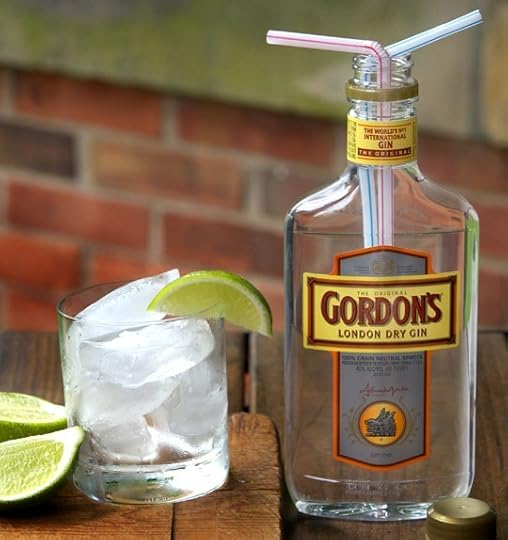
The Cranky Kaplan Cocktail. Photo by Donna Turner Ruhlman.
As my dear friend, the eminent biographer, Blake Bailey, knows, I am not to be trifled with in the morning. He actually tweeted that he’d sooner breakfast with a cobra. I’m angry that I’m conscious, I’m angry at the world, I’m angry at the stupidity in every direction, the mirror most of all. After I get a few hundred words under my belt and the writing work is underway, well, birds start to chirp and hope begins to dawn. So it was last Friday was when I made the error of checking Twitter first thing only to find this weird Dr. Hyde version of venerable journalist Peter Kaplan, making demands of me. He’s lucky I checked my twitter feed after today’s 750 words of deathless prose as he’s started it up again. Who the hell is this @CrankyKaplan asshole?
Here’s last week’s thread. He tweeted that he hoped my Friday Cocktail Hour had some gin in it. I’m a fan of gin, but it was the way he said it. Soon, a nasty little exchange was underway.
@CrankyKaplan: Where the fuck is @ruhlman’s Friday Cocktail? AND IT BETTER HAVE SOME FUCKING GIN IN IT.
It was morning. Hope had yet to dawn.
@ruhlman: not this time you pussy
@CrankyKaplan: HERE”S A COCKTAIL: 1 BOTTLE OF GIN, 2 STRAWS.
@ruhlman that’s not a cocktail that’s the enema you need, you cocksucker
As I said, grumpy. After @CK suggested that my cocktail—a lovely elixir of whiskey, ginger, vanilla, and Meyer lemon—was “A FUCKING TASTY BEVERAGE. FOR LADY LACROSSE PLAYERS” I decided enough was enough, be a man and let him veer off the Taconic on his Segway into a granite outcropping.
But then, sure as the sun, hope dawned several hours later. I thought, well, that’s not sounding so bad after all, bottle of gin, two straws, maybe that old crank was on to something. My dear old dad was a gin drinker—often it was a simple well-gin, on the rocks, with a squeeze of lime.
So the Friday Cocktail Hour is indeed, with dawning hope, a warm bottle of gin and two straws. And, overachievers, have one for The Ripper, over ice with a squeeze of lime.
The Cranky Kaplan
1 pint bottle of cheap gin
2 straws
Insert straws.
Suck.
Berate @ruhlman.
Makes 2 servings.
The same drink for the overachievers out there:
The Ripper Ordinaire
2 ounces cheap gin
1 juicy wedge of lime
Ice
Combine all in a glass, squeezing that juicy lime manfully.
If you liked this post … :
Join me in my surprise that the @CrankyKaplan is little more than a ruse by two highly regard city slicker journalists.
My recent cocktail posts that include gin are the Hasty Negroni, Boulevardier, Tom Collins, and the classic Manhattan.
Letherbee Original Label is an interesting Chicago gin you should try when you come to town.
The blog How Sweet It Is shares a recipe of a Gin and Tonic Cake.
A list of spring and summer gin cocktails.
© 2013 Michael Ruhlman. Photo © 2013 Donna Turner Ruhlman. All rights reserved.
May 22, 2013
Open Call For Artisan Food Businesses
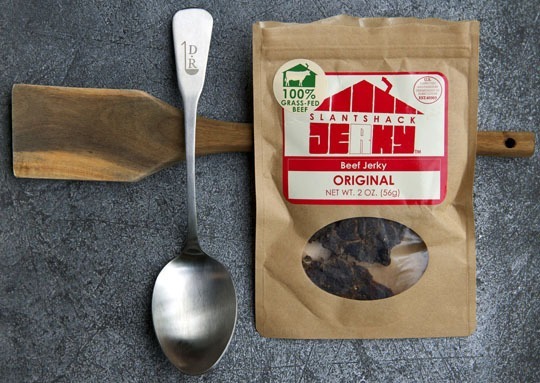
OpenSky is calling out to cool, small businesses. Photo by Donna Turner Ruhlman.
“You should get more of this,” my daughter, almost 18, said, chewing on some of SlantShack grass-fed beef Jerky. “It’s really good.”
Never mind her phrasing (would have been nice? “Beloved father, I would be eternally grateful to you and wash your car if you bought me another sample pack of this most excellent jerky”). But OK. She’s a jerky hound, I love her, so when I found this small jerky biz on the OpenSky site I gave it a shot.
I’d never have known about the Jersey-based business had it not been for OpenSky, an Internet marketplace that I’ve been a part of since before they even had a website (first post, 11/9/09). I just thought their concept was cool. People who know what they are talking about in a certain field (me: food and food tools) recommending what we think is excellent.
I hung in there with them through mucho growing pains and figurings-out, and they’ve morphed into something great: a virtual marketplace for small to midsized businesses that helps those businesses grow and promote their products. It’s not crafty like Etsy, not flash-sale-based like Gilt. I had no idea at the time that I’d start making my own kitchen tools, and become one of those very small businesses that OpenSky helps to promote via social media. Which I love. People can ask me questions, or they can comment on products, good and bad, like my Badass Perforated aka Egg Spoon, which I love (no link on purpose because at least one person is going to call me out for going too commercial; sorry, I make stuff, that’s what I do, I make books, and apps, and tools, and dinner most every night, the latter I pay for, the formers are how I pay for the latter).
John Caplan, the entrepreneur who conceived OpenSky, asked me to call out to the U.S. small business community to ask each business to consider opening a storefront on OpenSky. I can say for a fact that, though I sell my tools on my own site right here, separately from OpenSky (a lot of people requested this; many early email-overload glitch issues have since been addressed; I chose shopify.com, good but costs us nearly $2K a year), I have done 10 times the sales via OpenSky than via my site and OpenSky is free. We’re just a few of us here at ruhlman.com, but OpenSky has a fleet of customer service folks and now, at last, a really clean interface.
Here’s a video the news agency Reuters did on OpenSky recently; it explains OpenSky very well.
Are you a small business making cool products and can ship anywhere in the U.S.? OpenSky has 2.5 million potential individuals who might be interested in your stuff. Again here’s the link to the Merchants page. It’s free to join. I emailed SlantShack co-founder David Koretz if his experience had been good and he emailed this:
“OpenSky has been a great platform for our business—not only in regards to volume and revenue (it is a steady, reliable source in that regard), but most importantly it provides a larger venue for us to see how the consumer responds to our product and better understand how we need to market our jerky and communicate our brand goals in the long run.”
OpenSky already has some 2000 merchants (like Dalton-Ruhlman products and SlantShack) in all kinds of lifestyle categories, but I’m a food guy, 25% of OpenSky merchants are food related businesses, and here are some of my finds:
I’ve loved Olympic Provisions salumi since I visited the Portland restaurant and salumeria and am glad they partnered with OpenSky.
I’d never heard of Aqua Best but I’m eating lobster when I turn 50 this summer and that’s who I’m going to click on to order.
I don’t know what it is about soapstone, but there’s something going on there; can’t keep my hands off it. And this company, SPARQ, realized it.
And The Jam Stand, based in the culinary desert called Brooklyn, NY, would be relegated to that arid tundra were it not for OpenSky, which can promote their jam in every state of the country.
I’m a writer, first, and I love to cook, but in the broadest sense, I’m a maker, an entrepreneur, and want to support my fellow lunatics and society deviants who break their backs to make cool shit. Because in the end, it’s really fun. I like to have fun. Fun is good.
If you didn’t like this post, tell me. If you want a rant instead or some other cool links, see below:
My recent rant: America Has a Serious Eating Disorder.
Check out this great chef-focused Chicago retail store: The Butcher & Baker.
As I mentioned, I also write books and build cooking apps.
Here’s a recent review of my book Ratio by strangers on the blog Recipes Or Reservations, which calls it an “overlooked classic.” Well, I like the “classic” part…
Ideas in Food is always jam-packed with new thoughts and cooking techniques (and they have a new book coming out this fall, yay!).
© 2013 Michael Ruhlman. Photo © 2013 Donna Turner Ruhlman. All rights reserved.
May 20, 2013
Family Farms
Forrest Pritchard is a seventh-generation family farmer (skip this intro and read his guest post below if you’re pressed for time). His farm, Smith Meadows, is in Berryville, Virginia. The guy is clearly a lunatic, as his new book, Gaining Ground: A Story of Farmers’ Markets, Local Food, and Saving the Family Farm, shows (here’s the Publishers Weekly review of the book). He’s also started a blog (because he has so much time on his hands)—read this excellent post on What NOT to Ask the Grower at Your Local Market, it’s hilarious. Thanks to our mutual friend, Carol Blymire, Forrest offered to write a guest post I’m proud to put up here. I love to write about my region’s farmers, such as livestock farmer Aaron Miller and a record store clerk who got it in his head to raise chickens and taught me how to do process them—video here.
Forrest titled his own post, but if it were me, I’d have called it “The Importance of Lunatics” because the work is just too damn hard to rationalize. Or “Crazy People Are the Angels on Earth” because we need more people like Forrest. Or as he rightly notes: “Small Farmers Are the Real Heroes.”
Please read his guest post and his excellent memoir.
Do Family Farms Still Matter?
by Forrest Pritchard
In 1996, fresh out of college, I dreamed of returning to my family’s farm and becoming a farmer. After decades of eroding cattle prices, our Shenandoah Valley farm was barely hanging on. My parents had almost given up, taking jobs in the city just to keep the bills paid. I would be the seventh generation to work the land, dating back to the American Revolution, and took it upon myself to keep the farm alive.
As my friends headed off to graduate school, I pointed my dusty pickup toward the farm. My college advisors shook their heads with well-meaning disapproval. “Go ahead,” they admonished. “Get your hands dirty for a few months. But when you’re ready to decide on a career, the real world will be waiting for you.”
But this is the real world, I insisted. It’s a world of sunshine and rain. It’s a world of physical work and sweat, and the sweet satisfaction of nurturing life from the earth. A few weeks back on the farm, I was sunburned and filthy and utterly blissful. Most importantly, I was completely certain that I had made the right decision.
I projected our bills for the coming winter, and knew that we needed ten thousand dollars to carry us into spring. That summer, we planted the farm with corn and soybeans, abandoning our traditional cow pastures for the quicker financial return of grain. The meadows were killed off with herbicide, and the rolling hills cultivated.
In October, trucks whisked away our glittering corn and soy. I was so proud of what we had accomplished: We had saved our family farm. Later that week, I received our paycheck and tore open the envelope.
Staring at the check, I felt my knees buckle. The harvest hadn’t brought in ten thousand dollars. It hadn’t even cleared one thousand. After expenses, five truckloads of grain had made us a profit of eighteen dollars and sixteen cents.
How could this be? How could so much corn bring in such a pittance? Humiliated, furious, I nearly tore the paycheck into bits. At that instant, I realized how utterly broken our family farm was. I made up my mind that, somehow, we were going to fix it.
Seventeen years later, after triumphs and heartbreaks, our farm is stronger than ever. We now raise organic, grass-fed meats, and sell our free-range eggs at nearly a dozen bustling Washington, DC, farmers’ markets. Each weekend, I personally interact with hundreds of customers, answering questions and educating them about how we farm. Decades of debts are finally paid off. From where I stand, the future of farming has never looked so bright.
But our farm’s story is still the exception more than the rule. Late last year, when Secretary of Agriculture Tom Vilsack challenged rural America to reinvent itself, I couldn’t help but take notice. He called for a new attitude among farmers, a positive message to inspire young people to pursue careers in agriculture. He went so far as to say that rural America is now politically irrelevant, and that we need a new identity for agriculture in the twenty-first century.
You know what? He’s exactly right. This is how our own farm survived, by reinventing our mission. When we reversed course, changing from commodity-based crops to direct-marketed organic food, we turned a profit for the first time in a decade.
Americans will always need farms, and our health and wellbeing will depend on the quality of food these farms produce. But today, high-yield industrial agriculture rules the field. Only 1% of the country still lives on a farm, down from 50% just two generations before. If we’re going to save more family farms, we must rewrite the old story, and do it quickly.
It’s time to ask ourselves: What do we value? Do we believe in transparent farming practices, humane treatment of animals, and providing our producers with a living wage? It’s easy to sit in our ivory towers, dismissing these issues as glorified talking points. But when you’ve stood on your family’s farmhouse porch, and are handed eighteen dollars for an entire year’s worth of work, you begin to understand how truly desperate the situation can be.
People are ready for their farmers to become heroes. Who can blame them? The world needs heroes, those who believe in something greater than themselves. A new wave of farmers can live up to these ideals, and sustainable agriculture can be the story of our time. With more local, sustainable food options than ever before, the opportunity is now right in front of us. The shopping choices we make today will alter the landscape for generations to follow.
***
If you liked this post, take a look at these links:
My recent post on Farm Transparency v. Farm Secrecy.
Family Farm Defenders is a nonprofit organization supporting our family famers.
Looking for the closest farmers and farmers’ markets to you? Visit Local Harvest.
Civil Eats keeps up to date with all the politics in the American food system.
© 2013 Michael Ruhlman. Photo © 2013 Donna Turner Ruhlman. All rights reserved.
May 17, 2013
Friday Cocktail Hour: The Meyer Lemon Fig
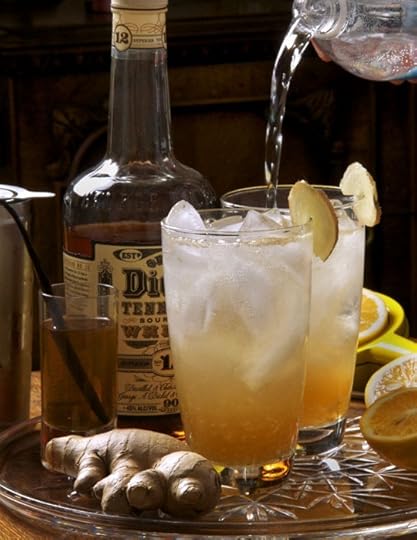
Michael Pardus’s Meyer Lemon Fig cocktail. Photo by Donna Turner Ruhlman.
This is a boldly flavored cocktail created by my chef, Michael Pardus, who teaches the cuisines of Asia at the Culinary Institute of America. Flavors galore—Meyer lemon, vanilla, ginger, American whiskey.
I especially admire the clever use of ginger from a chef who uses it all day long in class (he taught me to peel ginger with a spoon—works great; he sometimes adds fine julienne to the glass to chew on as he sips). All the elements swirl beautifully together (regular lemon juice will work too if you can’t find Meyers). For a light summer cocktail, he tops it off with a couple ounces of seltzer (and maybe an extra splash of whiskey if you’re Chef Pardus). The vanilla, delivered via a simple syrup, and ginger mix beautifully with the whiskey.
I chose Dickel Tennessee sour mash, my boon pal Blake Bailey‘s choice of American whiskey to have on hand (Pardus goes with bourbon, and I wouldn’t say no to rye). The flavor combo is so delicious I prefer it over ice, sans seltzer. Regardless, sparkling or on the rocks, it’s a fabulous cocktail.
Why the name Fig? You’ll have to ask Chef Pardus. In the meantime, enjoy this fine elixir.
Meyer Lemon Fig
4 ounces American whiskey
2 tablespoons vanilla simple syrup (see below)
2 tablespoons fresh Meyer lemon juice (or regular lemon juice)
1 teaspoon minced fresh ginger
Seltzer water and ice as needed or desired
Put whiskey, vanilla syrup, lemon juice, and ginger in a shaker with ice; shake well.
Fill a tall glass with ice, add shaker contents. Add seltzer to fill, and stir.
(Alternatively to steps 1 and 2: Divide ingredients equally between two lowballs, stir, and add ice.)
Rim edge of glass with a piece of cut fresh ginger.
Makes 2 tall sparkly drinks or 2 lowballs.
Vanilla Simple Syrup
1 cup sugar
1 cup water
2 tablespoons GOOD vanilla extract
Combine the sugar and water, bring to a boil or heat in a microwave to dissolve sugar, and let cool slightly.
Stir in vanilla extract, place in a plastic container, and refrigerate until ready to use. This is also great in coffee or cappuccino.
If you liked this post, take a look at these links:
My past cocktail posts with bourbon are the Boulevardier, Old Fashioned, and Mint Julep.
What makes a bourbon bourbon?
Headed south toward Kentucky and need something fun to do? Check out the Bourbon Trail.
Emilia is not really into bourbon, but a friend introduced her to Angel’s Envy and she likes it.
© 2013 Michael Ruhlman. Photo © 2013 Donna Turner Ruhlman. All rights reserved.
Michael Ruhlman's Blog
- Michael Ruhlman's profile
- 354 followers


